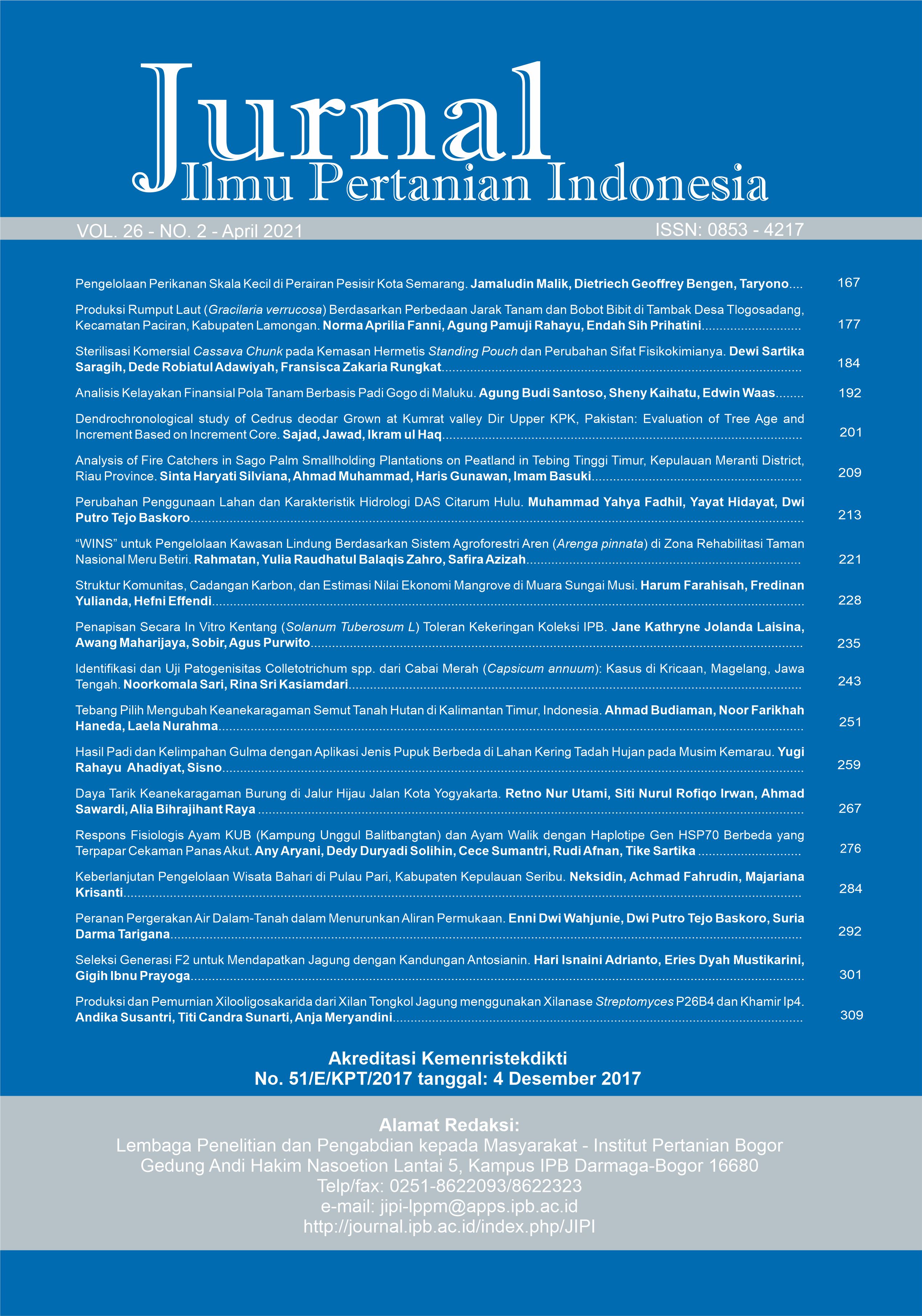Identifikasi dan Uji Patogenisitas Colletotrichum spp. dari Cabai Merah (Capsicum annuum): Kasus di Kricaan, Magelang, Jawa Tengah
Abstract
The investigation of the agent causing diseases is the first step to determine and control the spread of diseases. Anthracnose causing fruit rot on the red pepper in Indonesia that reduces the yield up to 90%. Colletotrichum is reported as the causative fungal agent of anthracnosis on the red pepper. This study aims to determine the type of Colletotrichum spp. pathogenic fungi on the red pepper collected from Agricultural Field Kricaan, Magelang, Central Java. Methods of identification included macroscopic and microscopic characterization and followed by determining the pathogenicity of the pathogenic agent. In this study, Colletotrichum gloeosporioides and C. acutatum are identified as the causative agents of anthracnose in the red pepper collected from the study location. C. acutatum PC3 strain is identified as the most virulent pathogenic agent.
Keywords: anthracnosis, diagnosis, diseases, symptoms, pathogen
Downloads
References
Istikorini Y. 2008. Potensi Cendawan Endofit untuk mengendalikan penyakit Antraknosa pada Cabai (Capsicum annum L.). [Tesis]. Bogor (ID): Institut Pertanian Bogor.
Kaur M, Sharma OP, Sharma PN. 2006. In Vitro effect of Thricoderma Species on Colletotrichum capsisi Causing Fruit Rot of Chilli (Capsicum annum L.). Indian Phytopath. 59(2): 243245.
Kim WG, Hong SK, Choi HW, Lee YK. 2009. Occurrence of Anthracnose on Highbush Blueberry Caused by Colletotrichum Species in Korea. Mycobiology 37(4): 310312.
Nurfalach DR. 2010. Budidaya Tanaman Cabai Merah (Capsicum annum L.). [Skripsi]. Surakarta (ID): Universitas Sebelas Maret.
Rajput RB. 2011. Organic Management of Rajput RB. 2011. Organic Management of Anthracnose of Chilli Caused by Colletotrichum capsisi (Syd.) Butler and Bisby. [Thesis]. Dhaward (ID): University of Agricultural Sciences.
Rojas EI, Rehner SA, Samuels GJ, Bael SAV, Herre EA, Cannon P, Chen R, Pang J, Wang R, Zhang Y, Peng Y, Sha T. 2010. Colletotrichum gloeosporioides s.l. associated with Theobroma cacao and other plants in Panama: multilocus phylogenies distinguish host-associated pathogens from asymptoomatic endophytes. Mycologia (102)6: 13181338
Semangun H. 2004. Penyakit-penyakit Tanaman Hortikultura di Indonesia. Yogyakarta (GB): UGM Press.
Shobah AN. 2014. Identifikasi Fusarium Penyebab Penyakit Layu Pada Tanaman Cabai (Capsicum annuum L.) dan Pengendaliannya dengan Mikoriza Vesikula Arbuskula (MVA). [Tesis]. Yogyakarta (ID): Universitas Gadjah Mada.
Sultana JL, Pervez Z, Rahman H, Islam MS. 2012. In-vitro Evaluation of Different Strains Trichoderma harzianum and Chaetomium globasum as Biological Control Agents seedling Mortality of Chilli. Bangladesh Research Publications Journal. 6: 305310
Syukur M, Sujiprihati S, Koswara J, Widodo. 2007. Pewarisan Ketahanan Cabai (Capsicum annuum L.) Terhadap Antraknosa yang Disebabkan Oleh Colletotrichum acutatum. Bul. Agron. 35(2): 112117.
Syukur M, Sujiprihati S, Koswara J, Widodo. 2009. Ketahanan terhadap Antraknosa yang disebabkan oleh Colletotrichum acutatum pada beberapa genotipe Cabai (Capsicum annuum L.) dan korelasinya dengan kandungan Kapsaicin dan Peroksidase. J. Agron. Indonesia. 37(3): 233239.
Than, P.P., Prihastuti, H., Phoulivong, S., Taylor, P.W.J and Hyde, K.D. 2008a. Review: Chilli antracnose disease caused by Colletotrichum species. Journal of Zhejiaang University Science. B9(10): 764778.
Than PP, Jeewon R, Hyde KD, Pongsupasamit S, Mongkolporn O, Taylor PWJ. 2008b. Characterization and pathogenicity of Colletotrichum spesies associated with anthracnose on chilli (Capsicum spp.) in Thailand
Thind TS, Jhooty S. 1990. Studies on variability in two Colletotrichum species causing anthracnose and fruit rot of chillies in Punjab. Indian Phytopathology. 43: 5358.
Peres NA, Timmer LW, Adaskaveg JE, Correll JC. 2005. Lifestyles of Colletotrichum acutatum. Plant Disease. 89(8):
Watanabe T. 2002. Pictorial Atlas of Soil and Seed Fungi (Morphologies of Cultured Fungi and Key to Species) 2nd Edition. CRC Press, USA
Wiratama IDMP, Sudiarta IP, Sukewijaya IM, Sumiartha K, Utama MS. 2013. Kajian Ketahanan beberapa Galur dan Varietas Cabai terhadap Serangan Antraknosa di desa Abang Songan Kecamatan Kintamani Kabupaten Bangil. E-Jurnal Agroekoteknologi Tropika. 2 2)
Wiratma DA, Murwani ER, Sastrahidayat IR. 1983. Pengaruh Komponen Cuaca Terhadap Tingkat Serangan Jamur Colletotrichum sp. Penyebab Antraknosa Pada Cabe Rawit di Laboratorium. Kongres Nasional PFI Ke VII Medan, 2123 September 1983. Medan (ID).
Wilia W. 2010. Potensi Cendawan Endofit dan Khamir untuk Mengendalikan Penyakit Antraknosa (Colletotrichum acutatum L.) pada Tanaman Cabai. [Tesis]. Bogor (ID): Institut Pertanian Bogor.
Zivkovic S, Stojanovic S, Ivanovic Z, Trkulja N, Dolovac N, Aleksic G, Balaz J. 2010b. Morphological and Moleculer Identification of Colletotrichum acutatum from Tomato Fruit. Pestic. Phytomed. (Belgrade) 25(3): 231-223.
This journal is published under the terms of the Creative Commons Attribution-NonCommercial 4.0 International License. Authors who publish with this journal agree to the following terms: Authors retain copyright and grant the journal right of first publication with the work simultaneously licensed under a Creative Commons Attribution-NonCommercial 4.0 International License. Attribution — You must give appropriate credit, provide a link to the license, and indicate if changes were made. You may do so in any reasonable manner, but not in any way that suggests the licensor endorses you or your use. NonCommercial — You may not use the material for commercial purposes.






















